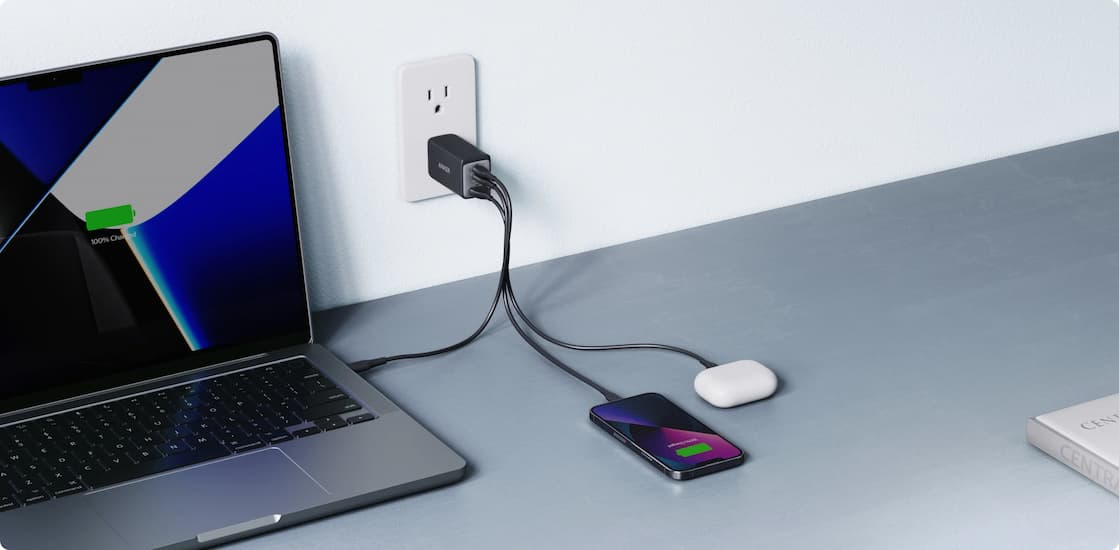
What is a PD charger? This article will help you understand it in seconds!
Table of contents

What is a PD Charger?
First, PD stands for Power Delivery. A PD charger is a fast-charging solution based on USB technology that delivers higher power, enabling faster and safer charging for a variety of devices such as smartphones, tablets, and laptops. It allows devices and chargers to "communicate" to ensure optimal power transfer, intelligently adjusting power supply based on each device’s needs, thereby improving charging efficiency.
What is USB-PD?
USB Power Delivery (USB-PD) is a versatile charging technology designed to power various USB devices. In the past, each USB device typically required a dedicated charging adapter, but this has completely changed now.
Since the USB Implementers Forum (USB-IF) released the USB PD 3.1 specification in 2012, a universal PD charger can now efficiently charge multiple different devices. The latest generation of USB-PD technology, combined with USB-C PD ports, can deliver up to 240W of power output, far surpassing previous technologies in charging speed and efficiency.
Key Features of PD Charging
USB-PD is an advanced charging technology known for its speed and energy efficiency. Below are the main features summarized based on USB-IF guidelines:
Higher Power Output: Thanks to PD fast charging, the maximum output power can now reach up to 240W, allowing devices like smartphones to recharge quickly.
Adjustable Voltage: Supports multiple voltage outputs, including 28V, 36V, and 48V. It also features an adjustable voltage mode, enabling devices to request the most suitable voltage level for more flexible and efficient charging.
Bidirectional Power Delivery: Unlike traditional charging, USB-PD supports bidirectional power flow. This means it can not only charge devices but also allow devices to power other accessories, such as charging a laptop with a smartphone.
Simultaneous Multi-Device Charging: USB-PD can charge multiple devices at once without causing overload. Low-power devices (e.g., earphones) draw only the minimum power they need, while high-power devices receive more power, making overall energy usage more efficient.
Intelligent Communication Mechanism: The charger and device can communicate with each other to allocate power on demand. This smart regulation optimizes charging speed while enhancing safety and overall efficiency.
Is PD Charging Safe?
USB PD chipsets precisely control power output. Whether connected to a laptop or a smartphone, the charger automatically identifies the device type and negotiates the most suitable power level, achieving fast charging while avoiding over-supply or damage to the device’s circuitry.
Most major smartphone brands have now adopted fast-charging technology, and phones are equipped with intelligent battery management systems that automatically activate protection mechanisms in various charging scenarios. Therefore, using a PD charger does not shorten the lifespan of a phone’s battery. However, it is important to use standard-compliant, high-power charging cables to avoid potential safety hazards such as cable overheating.
Conclusion
A PD charger is an accessory that can quickly charge various devices—even high-power-consumption laptops. It can deliver up to 240W of power, supports bidirectional charging, and prevents overcharging. However, to achieve safe fast charging, it is essential to use a compatible cable that meets specifications.
For example, Anker’s PD charger and dedicated fast-charging cable offer a reliable solution that leverages the advantages of PD technology while ensuring device safety.
Frequently Asked Questions (FAQ)
❓ Can a PD charger be used with any phone?
Yes, the vast majority of modern smartphones can be charged with a PD charger, but the charging speed depends on whether the phone supports the USB-PD protocol. PD-compatible phones will enable fast charging, while non-supported phones will charge at standard speeds. It is recommended to check the phone’s specifications to confirm PD compatibility.
❓ Are PD and USB-C the same thing?
No. USB-C refers to the type of physical interface and cable, while PD (Power Delivery) is a fast-charging protocol that operates over the USB-C interface. The two are often used together but are different technologies: USB-C is hardware, while PD is a software communication standard.
❓ How can I tell if I have a PD charger?
Usually, the product specifications or packaging will indicate terms such as "PD Fast Charging" or "Quick Charge." When connected to a device, if the device screen displays a lightning bolt symbol or a "Fast Charging" prompt, it means fast charging mode is active.
❓ What does PD mean in computers?
In laptops, PD (Power Delivery) is a fast-charging standard that enables chargers and computers to negotiate power levels. With the USB-C interface, it provides a more efficient and faster charging experience for laptops.
❓ Can USB-C PD transfer data and charge at the same time?
Yes. USB-C PD supports simultaneous data transmission and power delivery, but these are two separate functions. As long as both the cable and the device support the PD protocol and data transmission, you can charge and transfer data at the same time.
